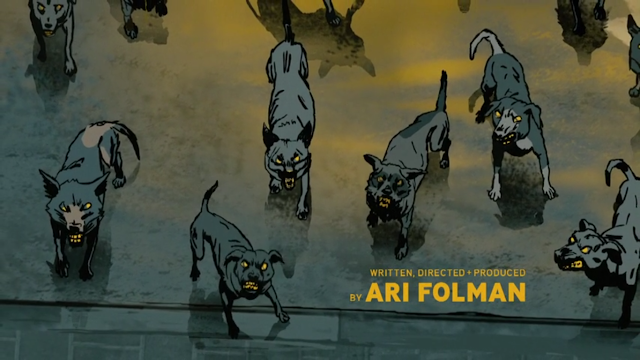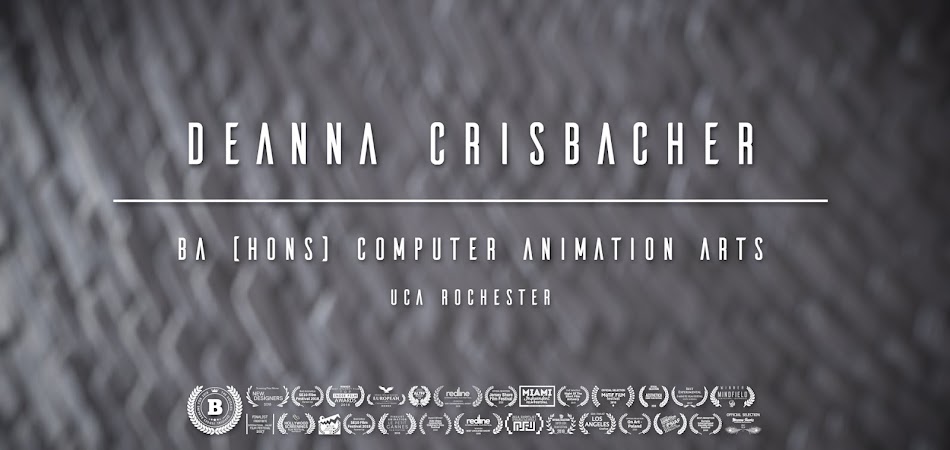 |
| Fig 1. Waltz With Bashir (2008) |
The opening of the film is perhaps the most striking and thrilling part of the film. It immediately sparks interest, immersion, and emotion. "It's a personal film, playing out as a kind of mystery, sparked by a bad dream. No opening shots here of rolling tanks, belching fire from their flattened heads. No thrum of propellers or burnt foliage to shock and draw us in. Instead we have a pack of snarling, red-eyed dogs, pelting through a city under an oppressive, mustard-gas sky, knocking down street furniture while mothers clutch their children in fear. As opening gambits go, this isn't just gripping: it throttles." (Jolin, 2008). This opening sequence sets the scene for the rest of the film as it uses complex, realistic animation combined with a graphic novel style to convey highly imaginative and dramatic events...both reality and dreams. This compelling sequence is a recurring dream that Folman's friend (and fellow ex-IDF soldier), Boaz, has been experiencing suddenly in relation to his experience in the Lebanon War. Boaz asks Folman if he remembers anything from the Lebanon War, which causes him to realise that he cannot recall much of his life during this time. This is the catalyst of Folman's quest to recover the memories that he has buried deep within his mind.
 |
| Fig 2. 26 Dogs |
It can be argued that this animated graphic-novel style animation represents Folman's detachment from the events he experienced as a young, teenage soldier. The animation not only allows for us to see the expressions of those being interviewed as you would in a live action documentary, but we are also able to see their memories and dreams, "Folman is an Israeli documentarian who has not worked in animation. Now he uses it as the best way to reconstruct memories, fantasies, hallucinations, possibilities, past and present. This film would be nearly impossible to make any other way. Animation will always be identified, no doubt, with funny animals, but is winning respect as a medium for serious subjects," (Ebert, 2009). Not only does animation allow the viewer to see what the individuals have experienced or dreamed, but it perhaps makes the explicit imagery more palatable for a wider audience.
This is interesting, however, as other films containing violence or war in a live action medium does not seem too extreme for many viewers. However, the way that film presents the dreams and flashbacks of the ex-soldiers makes the film emotionally dense...even with the animation it's hard to not feel an aura of dread, regret and guilt. "Perhaps there is something obscene about how jaded you get, but eventually you stop cowering beneath the onslaught up on screen and suppress a yawn as another missile turns a building to rubble, another bullet-wound fountains with blood. 'Desensitised' is the word. Yet I don't think anyone will be blasé after watching Waltz with Bashir," (Quinn, 2009). Perhaps the inventive use of gripping, trippy animation with a combination of different types of music keeps the different stories equally disturbing by refreshing the audience. Each story we hear is different, with different personalities playing part in the individuals reactions to war. Each one leads to the grim truth that Folman and many other soldiers took part in and/or witnessed, whether it was actively or passively.
 |
| Fig 3. Memories |
Bibliography:
Bradshaw, P. (2008) Waltz With Bashir At: https://www.theguardian.com/film/2008/nov/21/waltz-with-bashir-folman Accessed on: 16/2/2017
Calhoun, D. (2008) Waltz with Bashir At: https://www.timeout.com/london/film/waltz-with-bashir Accessed on: 16/2/2017
Ebert, R. (2009) Waltz with Bashir At: http://www.rogerebert.com/reviews/waltz-with-bashir-2009 Accessed on: 16/2/2017
Horne, P. (2009) Waltz with Bashir DVD, review At: http://www.telegraph.co.uk/culture/film/5060249/Waltz-with-Bashir-DVD-review.html Accessed on: 16/2/2017
Jolin, D. (2008) Waltz With Bashir Review At: http://www.empireonline.com/movies/waltz-bashir/review/ Accessed on: 16/2/2017
Quinn, J. (2009) Waltz With Bashir (18) At: http://www.independent.co.uk/arts-entertainment/films/reviews/waltz-with-bashir-18-1027847.html Accessed on: 16/2/2017
Scott, A.O. (2008) Inside a Veteran's Nightmare At: http://www.nytimes.com/2008/12/26/movies/26bash.html Accessed on: 16/2/2017
Illustration List:
Figure 1. Waltz With Bashir [Poster] At: http://goldbergblog.com/movies/posters/waltzwithbashir.jpg Accessed on: 16/2/2017
Figure 2. 26 Dogs [Film Still] At: http://sinnerscreek.com/wp-content/uploads/2015/06/Screenshot-from-2015-05-26-18_49_12.png Accessed on: 16/2/2017
Figure 3. Memories [Film Still] At: https://4.bp.blogspot.com/-NwFQ8lrKfwA/VuFWN-neiXI/AAAAAAAAAfM/_sLJrE7869g/s1600/WaltzWithBashir1.jpg Accessed on: 16/2/2017

No comments:
Post a Comment